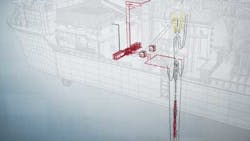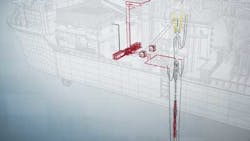Asia/Pacific spurs demand for integrated deepwater MPD systems
Chad Wuest
James Riddoch
Mark McHardy
Ardia Karnugroho
Julius Ceazar L. Sosa
Scott Bremner
Julmar Shaun S. Toralde
Weatherford
Deepwater drilling is quickly moving toward managed pressure drilling (MPD) methods as a standard, rig-ready capability on floating rigs. This transition is being driven in large part by carbonate drilling in the Asia/Pacific region where MPD provides the only effective means to counter extreme losses of circulation. Over the last decade, pressurized mud cap drilling (PMCD) has made MPD a critical tool for drilling these difficult carbonate formations, especially in offshore settings.
The demand for that capability has fueled an evolution in MPD technology that has grown from basic closed-loop circulation system capabilities on fixed structures to full riser-integrated systems on dynamically positioned drilling vessels. In deepwater venues more than 75 wells have been drilled from floating rigs using MPD, and about 80% of those have been drilled in the Asia/Pacific region.
The MPD evolution
Growing Asia/Pacific demand for MPD services along with the associated long lead times for outfitting rigs has spurred industry efforts to integrate MPD systems through retrofitting or with shipyard newbuilds. Three Weatherford MPD drilling applications in the region illustrate the evolution of the technology toward achieving a fully integrated capability on board dynamically positioned vessels.
Before MPD was used in Asia/Pacific deepwater applications, it was primarily employed on a contingency basis when conventional drilling methods were ineffective. In 2003, Asia/Pacific operators changed that focus when they began to use MPD on a floating rig to mitigate loss circulation problems when drilling through carbonates. These pioneering applications are some of the earliest uses of MPD. Its continuing success in drilling these wells has played a pivotal role in advancing the technology and its integration on dynamically positioned drilling vessels.
The high use of MPD systems and the prevalence of carbonated systems in the Asia/Pacific region created a strong need to have MPD capabilities already in place on the rigs, instead of waiting for a problem to occur before deployment.
MPD matured as operators gained experience and the technology steadily advanced. Most notably, its application broadened from just tackling the carbonates to increasing the overall efficiency of the drilling process. Operators began to take full advantage of the unique capabilities afforded by a closed-loop circulating system.
In this process, the focus changed from a specific segment of the wellbore (where loss circulation was occurring) to the entire wellbore. With the MPD system in place, there were many opportunities to increase drilling efficiency such as real-time monitoring and managing of wellbore pressures, early kick loss detection, ballooning during connections, and riser gas mitigation.
Broadening the application of MPD to the entire wellbore was also important from the standpoint of fully integrating the system. Integration meant MPD was passive in terms of conducting conventional rig operations, but almost instantly available when needed.
RCD technology
The hallmark of MPD technology and its key differentiator from a conventional circulation system that is open to the atmosphere is the rotating control device (RCD). By diverting annular flow to an automated MPD choke manifold, the RCD effectively creates the closed-loop circulation system necessary for MPD operations. Within this pressurized system, surface backpressure can be monitored and adjusted to respond to small pressure and flow oscillations in the wellbore, and to vary equivalent circulation density (ECD) instantaneously, without changing mud weight, to alter downhole pressure.
For example, the PMCD method of drilling with severe losses uses an under-balanced sacrificial fluid for the drilling fluid, which requires the application of annular pressure on the well while drilling. Doing this requires little more in terms of hardware than an RCD and the MPD choke, which made PMCD a good starting point for developing MPD technology.
The evolution of MPD rig integration is fundamentally the addition of new technologies and experience to this basic PMCD application. This process has produced an entire deepwater MPD system that allows seamless shifting between modes of MPD, from surface monitoring to constant bottomhole pressure and PMCD.
Early marine MPD
The mechanical core of the RCD is the bearing assembly that seals around the drill pipe while allowing it to rotate. In early marine MPD operations from jackups and platforms, the bearing assembly complicated the rig's conventional operations. Installing or removing it for full bore access or for bearing maintenance required rig-up and rig-down of a bell nipple on top of the BOP. There were also internal diameter restrictions that made changes problematic. In addition, the work took place below the rig floor where it presented risk to personnel and increased the opportunity for spillage.
The solution lay in the development of a docking station RCD that allowed the bearing assembly to be deployed through most rotary tables. When MPD is needed, the bearing assembly is easily and quickly run into the hole and landed in the docking station. When full bore access to the hole is required, the bearing assembly is similarly retrieved. This innovation removed a major impediment to the adoption of MPD and integrating it into the rig.
Displaying 1/2 Page 1,2Next>
View Article as Single page

